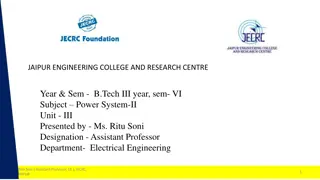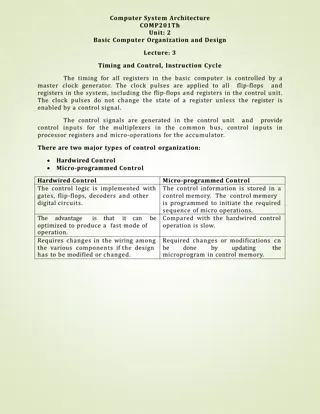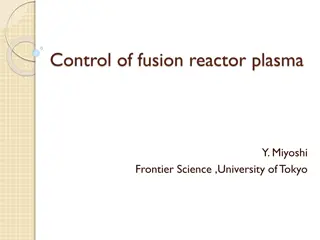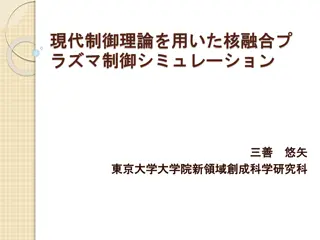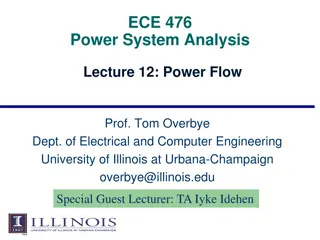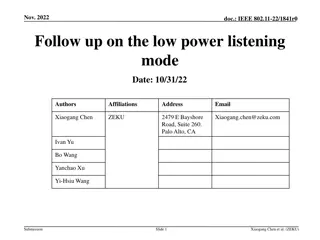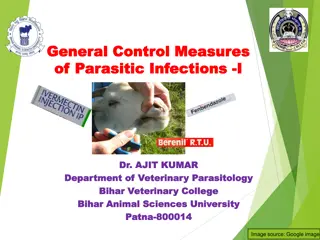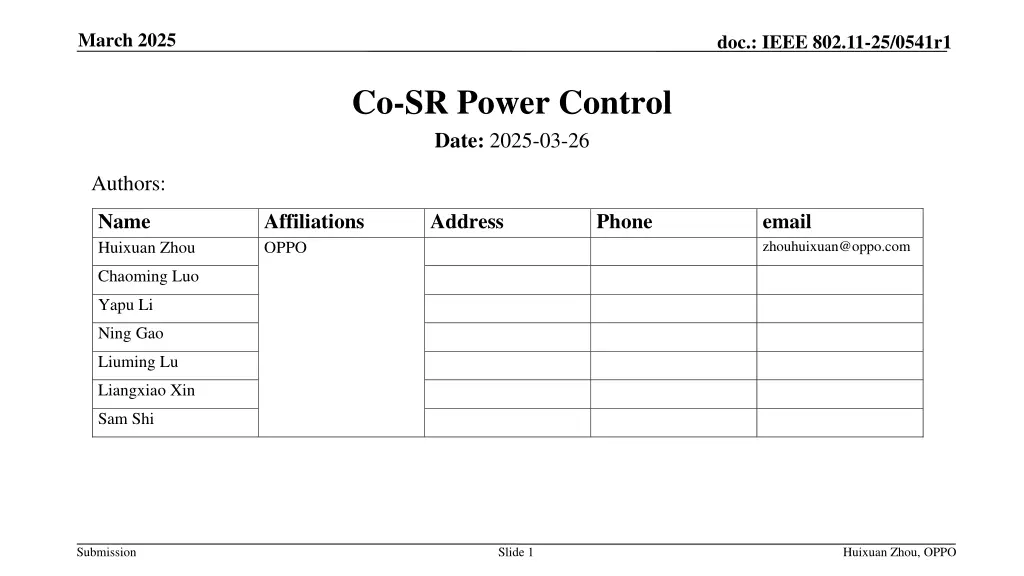
IEEE 802.11-25/0541r1 Coordinated Spatial Reuse Power Control
Explore the power control solution for Coordinated Spatial Reuse (Co-SR) in the IEEE 802.11 standard, addressing methods and information exchange between access points. Learn about power limitation in Co-SR compared to Parametrized Spatial Reuse (PSR) and how APs determine maximum TX power limits for efficient DL transmissions. Understand the dynamic parameters involved and their impact on AP TX power limits in Co-SR scenarios.
Download Presentation

Please find below an Image/Link to download the presentation.
The content on the website is provided AS IS for your information and personal use only. It may not be sold, licensed, or shared on other websites without obtaining consent from the author. If you encounter any issues during the download, it is possible that the publisher has removed the file from their server.
You are allowed to download the files provided on this website for personal or commercial use, subject to the condition that they are used lawfully. All files are the property of their respective owners.
The content on the website is provided AS IS for your information and personal use only. It may not be sold, licensed, or shared on other websites without obtaining consent from the author.
E N D
Presentation Transcript
March 2025 doc.: IEEE 802.11-25/0541r1 Co-SR Power Control Date: 2025-03-26 Authors: Name Huixuan Zhou Affiliations OPPO Address Phone email zhouhuixuan@oppo.com Chaoming Luo Yapu Li Ning Gao Liuming Lu Liangxiao Xin Sam Shi Submission Slide 1 Huixuan Zhou, OPPO
March 2025 doc.: IEEE 802.11-25/0541r1 Introduction TGbn defines multi-AP Coordinated Spatial Reuse (Co-SR) at TXOP-level with power control [1]. There have been discussions on power control methods, but no consensus have been reached yet on this topic. In [2], The Trigger frame that initiates the Co-SR transmission indicates the TX power limit of the shared AP. In [3] and [4], ICF and ICR are porposed for exchanging control information between APs to support power control. In this contribution, we introduce a power control solution for Co-SR with some shared information, and using ICF/ICR exchange to facilitate power control. Submission Slide 2 Huixuan Zhou, OPPO
March 2025 doc.: IEEE 802.11-25/0541r1 Recap: Power Limitation in PSR 802.11ax introduces the Parametrized Spatial Reuse (PSR) mechanism, which allows an HE STA to identify a PSR opportunity for the duration of an ongoing TB PPDU. An AP that aims to use PSR determines an Acceptable Receive Interference Level (ARIL) in dBm ??????= ?????? ?????? ?????? ??????: expected receive signal power of the ensuing HE TB PPDUs ??????: minimum SNR value that yields 10% PER ?????? : safety margin value The AP determines the ????????parameter, and finds ??????as the highest value less than or equal to ???????? in Table 27-24. ????????= ???????+?????? If an HE STA receives a inter-BSS TF that allows PSR and its expected TX power does not exceed the power limit specified in the TF, it will identify a PSR opportunity. ????????? 10 ???10 ?????,??????? ?????? ???????,20??? ?????,???????: number of non-punctured 20 MHz subchannels of the PSRT PPDU ???????,20???: normalized received signal power in units of dBm/20MH Submission Slide 3 Huixuan Zhou, OPPO
March 2025 doc.: IEEE 802.11-25/0541r1 Power Limitation in Co-SR Unlike PSR, Co-SR involves simultaneous DL transmissions. When AP1 utilizes Co-SR for delivering DL PPDU to STA1, it shall determine the maximum TX power limit of AP2: ???= ???????1+ ??? ????(??2 ???1) AP1 AP2 a) ?????2 b) ???????1= ?????????????1 ?????? ?????? c) ?????????????1= ?????1 ??? ????(??1 ???1) It can be derived from a), b) and c) that : ?????2 ??? ????(??2 ???1) (Sharing AP) (Shared AP) STA1 ???= ?????1 ??? ????(??1 ???1) ?????? ?????? + The same way is used for AP2 to determine the maximum TX power limit of AP1. Based on the above equation, we can draw the following conclusion: Except for the AP TX power, the other items on the right side of the equation are semi-static parameters related to the STA, and the AP can obtain these parameters through the measurement procedure. The maximum TX power limit of OBSS AP solely depends on the AP s TX power. STA2 Submission Slide 4 Huixuan Zhou, OPPO
March 2025 doc.: IEEE 802.11-25/0541r1 Power Control for Co-SR (1/4) In this contribution, we assume that the APs have completed both the MAP negotiation and the Co- SR measurement procedure, and have already obtained measurement results related to their STAs (i.e., Pathloss, minimum SNR and other TBD parameters). Information required for power control at an AP: Expected TX power: The expected TX power to send DL PPDU during Co-SR transmission. Maximum TX power limit of OBSS AP: Determined by the expected TX power of the AP and the measurement results. Power headroom (or Maximum TX power): The gap between the expected and the maximum TX power of the AP in units of dB. Minimum TX power: The minimum TX power by the AP, ensuring that its STA is available to decode the PPDU without interference from OBSS AP. Submission Slide 5 Huixuan Zhou, OPPO
March 2025 doc.: IEEE 802.11-25/0541r1 Power Control for Co-SR (2/4) Power negotiation procedure between sharing AP and shared AP are as follows: Step1: Sharing AP and shared AP calculate their own power control information based on measurement. Step2: Shared AP shares its power control information to sharing AP. Step3: With knowledge of global power control information, sharing AP can decide whether to do Co- SR or not and perform STA selection. Step4: The sharing AP informs the shared AP if there is a change in the TX power parameters. Submission Slide 6 Huixuan Zhou, OPPO
March 2025 doc.: IEEE 802.11-25/0541r1 Power Control for Co-SR (3/4) Example: An AP with knowledge of global power control information can adjust parameter values to meet the power requirements of both sharing AP and shared AP. AP1-> STA1 AP1-> STA1 AP2 s power cannot be reduced to 4dBm ( 5dBm), So AP1 increase its power by 6dB instead 11dBm 5dBm Expected TX power Maximum TX power limit of AP2 AP1 AP2 10dBm ( 10dBm, 10dBm) 4dBm ( 10dBm, 10dBm) (Sharing AP) (Shared AP) STA1 4dB 10dB Power headroom 3dBm 3dBm Minimum TX Power Expected TX power of AP1 STA3 AP2-> STA2 AP2-> STA2 STA2 10dBm 10dBm Expected TX power Adjusted TX power of AP1 Maximum TX power limit of AP1 12dBm ( 5dBm) 12dBm ( 11dBm) 5dB Power headroom 5dB 5dBm AP1 AP2 Minimum TX Power 5dBm (Sharing AP) (Shared AP) AP2-> STA3 AP2-> STA3 STA1 AP2 discards STA3 because it cannot meet the requirements no matter how the power is adjusted. 10dBm Expected TX power 10dBm Maximum TX power limit of AP1 10dBm ( 5dBm) 10dBm ( 11dBm) STA3 STA2 Slide 7 5dB 5dB Power headroom 5dBm 5dBm Minimum TX Power Submission Slide 7 Huixuan Zhou, OPPO
March 2025 doc.: IEEE 802.11-25/0541r1 Power Control for Co-SR (4/4) The benefits of AP gathering global power control information before performing Co-SR: Using global information for power control overcomes the limitation of an AP recommending power for an OBSS AP based solely on its own information. For example: While recommending the maximum TX power limit for the OBSS AP, the AP is unaware of its impact on the OBSS STA, which can potentially lead to transmission failure. In some cases, the APs cannot do Co-SR transmission due to one AP s power cannot be reduced below its minimum TX power. Since no shared information like power headroom is provided, Co-SR cannot be achieved in an alternative way: increasing the other AP s TX power. Therefore, it is important to negotiate the power in advance to avoid sudden transmission failures before performing Co-SR transmission. AP can also perform STA selection from more than one candidate STAs based on this information. Submission Slide 8 Huixuan Zhou, OPPO
March 2025 doc.: IEEE 802.11-25/0541r1 Co-SR Power Control Negotiation The power control negotiation is done by performing ICF/ICR exchange during the polling phase Before Co-SR transmission. Whether to allow more than one candidate shared AP is TBD. Sharing AP gather global power control information Pre-transmission: AP1 selects one or more candidate STAs. ICR: If AP2 is willing to participate, the ICR includes the shared power control information of its candidate STAs. Co-SR trigger: Based on known information, If AP1 decide they cannot do Co-SR, it will not send the Co-SR trigger. If AP1 decides to initiate Co-SR, it first perform STA selection, and: If AP1 the power of either AP needs to be changed, the Co-SR trigger includes the adjusted TX power limit of AP2 . Or it includes the original TX power limit of AP2. Shared power control information TXOP Co-SR Trigger DL PPDU ICF AP1 (Sharing AP) DL PPDU ICR AP2 (Shared AP) power limit of AP2 BA STA1 BA STA2 Submission Slide 9 Huixuan Zhou, OPPO
March 2025 doc.: IEEE 802.11-25/0541r1 Summary This contribution introduces a power control solution based on shared power control information for Co-SR. Power control signaling based on ICF/ICR exchange is proposed. Submission Slide 10 Huixuan Zhou, OPPO
March 2025 doc.: IEEE 802.11-25/0541r1 Straw Poll SP: Do you support to include the following text to 11bn SFD? In UHR Co-SR, Sharing AP needs to obtain global power control information before Co-SR transmissions. The following shared power control information shall be carried in the ICR during the polling phase before Co-SR transmission: Expected TX power Maximum TX power limit of sharing AP Power headroom (or Maximum TX power) Minimum TX power The adjusted TX power limit for shared AP shall be carried in the trigger frame that initiates Co-SR. Submission Slide 11 Huixuan Zhou, OPPO
March 2025 doc.: IEEE 802.11-25/0541r1 References [1] 11-24-0209-12-00bn-specification-framework-for-tgbn [2] 11-25-0254-00-00bn-co-sr-power-control-considerations [3] 11-24-1514-01-00bn-multi-ap-framework-for-c-sr [4] 11-25-0343-00-00bn-consideration-on-multi-ap-framework-for-co-sr Submission Slide 12 Huixuan Zhou, OPPO




